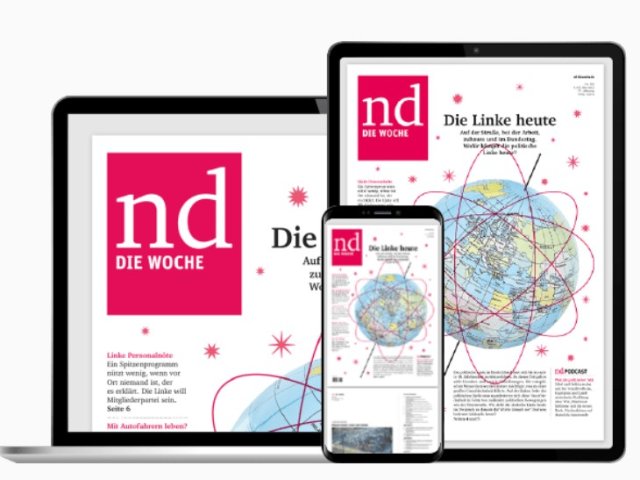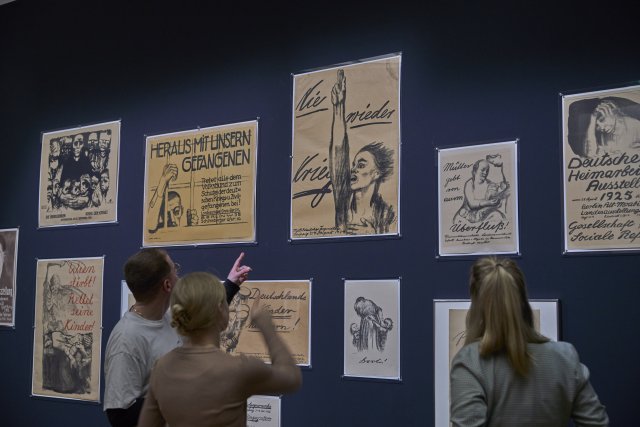Two visitors in front of some political works by Käthe Kollwitz
Photo: DPA/Städel Museum, Frankfurt am Main
Her Majesty raged. She will not set foot in the exhibition until this terrible poster has disappeared. From a class point of view, it is only logical that Empress Auguste Viktoria reacted so harshly. Finally, with her contribution to the “German Home Work” exhibition in 1906, Käthe Kollwitz destroyed all the lies of the Wilhelmine authoritarian state. Because the exhausted woman with the dark-rimmed eyes, whose face was torn from the advertising pillars, screams the social truth of the time into the world: “Work makes you sick, work kills!”
A radical message. It’s all the more surprising that everyone can agree on Kollwitz. From the former GDR, where she was honored as a steadfast anti-fascist and lion mother of the proletariat, to the CDU patriarch Helmut Kohl. Against the resistance of well-known experts, the former Chancellor decided in the 1990s to equip the central memorial of the Berlin Neue Wache with an enlarged replica of a Kollwitz Pietà.
According to the laws of the canon, so much agreement across ideological divides should actually indicate a supra-historical assertiveness. But what independent stylistic quality, which cannot be taken over by the moods of the day, speaks for the work of the graphic artist and sculptor, who became a leading pacifist after the war death of her son Peter in 1914? The artist’s presence in school and street names gives her person more publicity than her oeuvre. In this respect, it is a known unknown that the Städel Museum in Frankfurt am Main is now examining in all its facets with a large exhibition of works. Around 100 graphics as well as some sculptures and paintings have been brought together.
The exhibition approaches Kollwitz about Kollwitz. An entire gallery of self-portraits welcomes those who enter. The artist saw her first-person studies as expressions of a program early on. Her looks in the mirror reveal that she never wanted to be nice. Here a brooding head propped up and a pouting lower lip, there thoughtful eyes above dark gray bags under his eyes.
In 1867 the daughter of a lawyer who was not allowed to work in the civil service and therefore first became a bricklayer and later a preacher was born in Königsberg. She enjoys a rare privilege: her parents finance her artistic training at the Munich “Damenakademie”. The quickly dashed impressionism of Bavarian beer garden scenes remains the probatory interlude of a searcher who has not yet found herself. But then she comes across Max Klinger’s dark etching art. The colorless genre immediately captivates the painting student. She forgets her brush and palette.
With the turn to gray and black, the subjects also change. Kollwitz discovers the precarious milieu that the bourgeois art of the Belle Époque usually ignores. Before the cycle “A Weber’s Revolt” (1893–1897), higher-ranking daughters would probably have taken out the handkerchief and held it in front of their noses, so ruthlessly does Kollwitz expose the misery of the industrial proletariat.
Nevertheless, curator Regina Freyberger does not describe such sheets as “socially critical,” but rather as “socially thematic.” The consistent focus on those affected by poverty does not result solely from social concern or emancipatory drive, at least not in the early years. The artist recognizes a visually fresh world of motifs in the poorly paid toilers: “Such a working-class woman,” says Kollwitz, “shows me much more about her shape and nature than the lady who is limited in her actions by convention.”
Unlike her social democratic husband, the artist has never belonged to a party. Karl Kollwitz practices in Berlin as a statutory health insurance doctor, which around 1900 meant “poor doctor.” Through his work, the wife is also directly confronted with economic hardship – and makes the left-wing cause more and more her own. Especially after 1918, creative work merged with activism. In 1924, for example, the imploring poster “Never again war” was created for the “Socialist Workers’ Youth,” which the West German peace movement would still use half a century later.
Perhaps for the first time ever, Kollwitz gives the resistance a female face: in a woodcut from the early 1920s (which later becomes a sculpture), mothers stand protectively in front of their sons in order to protect them from another, patriotically disguised mass murder.
The “Memorial Sheet for Karl Liebknecht” (1919) illustrates how differentiated Kollwitz wrestles with design issues despite personal concerns. In the morgue she draws the murdered man, later in the studio the perfectionist experiments with lithography and etching until she decides on the hard-edged woodcut as the medium of choice.
Small-format graphics and massive sculpture do not function as opposites. In both genres the emphasis is on the gestural-emotional rhetoric of the body. Rearing up in pain, faces seeking protection behind hands, or desperate hugs like in the bronze group “Mother with Two Children” (between 1932 and 1936). In addition to the pathos formulas of the Christian tradition, modern expressive dance has also left its mark. In this way, Kollwitz finds a serious beauty that is carefully underlined by the deep blue paint on the walls in the Städel.
The exhibition achieves a difficult balancing act. It honors the aesthetic strength without taking away the political sting of the oeuvre. Could the offer to rediscover the artist come at a more historically opportune time than in the socially turbulent present of 2024? Before someone, like the CDU recently, wants to destroy citizens’ money with a vulgar liberal ax, they should first take a look at the heartbreaking charcoal drawing “Unemployment” (1909). Leaden fear of the future shadows the sick mother’s face.
Kollwitz condenses the intimate insights into the lower class that were revealed to the husband during his medical home visits into existential dramas. These may come from a different era, but we still clench our fists in the face of dying children and starving mothers. Because Kollwitz forces you to look. To where asymmetrical ownership structures make the world even uglier. The rousing show will certainly once again reveal parallels between our neoliberal present and the derailed capitalism of the past. However, all of this derives its relevance from its humanistic timelessness. Käthe Kollwitz created images against a compassionless society.
“Kollwitz”, until June 9th, Städel Museum, Frankfurt am Main
Subscribe to the “nd”

Being left is complicated.
We keep track!
With our digital promotional subscription you can read all issues of »nd« digitally (nd.App or nd.Epaper) for little money at home or on the go.
Subscribe now!
sbobet judi bola sbobet88 sbobet88
